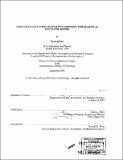| dc.contributor.advisor | James L. Elliot. | en_US |
| dc.contributor.author | Hilbert, Bryan (Bryan Nathaniel), 1977- | en_US |
| dc.contributor.other | Massachusetts Institute of Technology. Dept. of Earth, Atmospheric, and Planetary Sciences. | en_US |
| dc.date.accessioned | 2010-04-28T15:33:29Z | |
| dc.date.available | 2010-04-28T15:33:29Z | |
| dc.date.copyright | 2001 | en_US |
| dc.date.issued | 2001 | en_US |
| dc.identifier.uri | http://hdl.handle.net/1721.1/54444 | |
| dc.description | Thesis (S.M.)--Massachusetts Institute of Technology, Dept. of Earth, Atmospheric, and Planetary Sciences, 2001. | en_US |
| dc.description | Includes bibliographical references (leaf 41). | en_US |
| dc.description.abstract | We present a new method of calculating model lightcurves for stellar occultations by the Jovian planets. We model the occulting planet as a three-dimensional body of non-zero ellipticity, and define two ellipses of intersection with the body which dictate the appearance of the lightcurve. These include the visible-limb plane ellipse, which is the observed figure of the body as seen in the sky, and the line-of-sight ellipse, which contains the line of sight to the occulted star, and is the plane in which the starlight is refracted. The observed stellar flux during the occultation is primarily dictated by the ellipticity and subsequent radius of curvature of the instantaneous ellipse in the line-of-sight plane. This new method is applied to several test cases, as well as to the Jovian occultation of HIP9369 on 10 October 1999. Lightcurves generated by this model are compared to identical situations using the method published in Hubbard et al. (1997), showing that the Hubbard model works well for low-latitude occultations, but fails at higher latitudes. In the case of the high-latitude Jovian occultation, the best-fit lightcurve, produced from this new method, yielded a half-light equatorial radius of 71,343±1.2 km with a scale height of 19.25±0.5km, and an isothermal temperature of 139K. The same data, fit using a lightcurve generated by the method described in Hubbard et al. (1997), resulted in a half-light equatorial radius of 71,819km with a scale height of 17.9km with errors comparable to the previous fit, resulting in an isothermal temperature of 129K. Lightcurves are numerically generated for an ellipsoidal planet and, for comparison, an approximation to the ellipsoidal case consisting of a sphere with radius equal to the radius of curvature of the ellipsoid at the half-light point. We find that in the case of an occultation where the line-of-sight ellipticity does not vary, that the radius of curvature approximation matches the ellipsoidal planet lightcurve to within 0.007%. For an oblique occultation however, the line-of-sight ellipticity varies, and the approximation, using only a single radius of curvature sphere, is only good to about 1%. As a result, we find that using a model such as that presented in Baum and Code (1953) to fit the lightcurve of an ellipsoidal planet can return values for half-light radius (after accounting for the distance between the center of curvature and the center of the body) which may match the local distance to the center of the ellipsoid to a fraction of a percent, while returning values of scale height which may be in error by several percent. Test cases are also then put through numerical inversions, to obtain temperature versus pressure profiles. Test cases with spherical planets return temperature profiles that match those used to create the lightcurves, while test cases with ellipsoidal planets return temperature profiles which can differ from the input temperatures by tens of degrees, assuming a constant local gravity over the course of the occultation. | en_US |
| dc.description.statementofresponsibility | by Bryan Hilbert. | en_US |
| dc.format.extent | 41 leaves | en_US |
| dc.language.iso | eng | en_US |
| dc.publisher | Massachusetts Institute of Technology | en_US |
| dc.rights | M.I.T. theses are protected by
copyright. They may be viewed from this source for any purpose, but
reproduction or distribution in any format is prohibited without written
permission. See provided URL for inquiries about permission. | en_US |
| dc.rights.uri | http://dspace.mit.edu/handle/1721.1/7582 | en_US |
| dc.subject | Earth, Atmospheric, and Planetary Sciences. | en_US |
| dc.title | Stellar occultation lightcurve modeling for elliptical occulting bodies | en_US |
| dc.type | Thesis | en_US |
| dc.description.degree | S.M. | en_US |
| dc.contributor.department | Massachusetts Institute of Technology. Department of Earth, Atmospheric, and Planetary Sciences | |
| dc.identifier.oclc | 50398802 | en_US |
